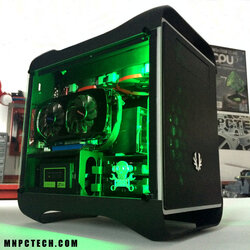Hello everybody.
In the past months I've been spending my time and money bulilding my first PC. It turned out great, I'm happy of my first oveclocked gaming PC, if it wasn't for the noise my video card makes.
I have been watching some AIO WC solutions but no one fits my needs, so I've been thinking about bulding a custom loop or modding an AIO kit, which seems more cost effective, but I need some hints from you guys before proceeding since I never sized a WC system.
The screaming video card is a Zotac GTX 970 @ 106%, core +190, memory + 300
To start with, should I put a waterblock also on my CPU since I'm at it? It's a [email protected] GHz cooled by an Arctic Cooling freezer extreme V2, which gives me resonable temps being relatively quiet.
The problem here is that I have a small mini-ITX PC, I'm lucky enough to have room for radiators but not that much, keeping that beast of a dissipator inside will take out space I need to fit a 120.2 radiator, leaving me with 2 spots for a 120.1 radiators. Removing that makes up space for a 120.2 + 120.1 radiator.
And here is the field where I really need help: how many radiators should I put in for my overclocked system? I have no idea if a 120.2 is enough for both GPU and CPU but I doubt it, should I use the whole combo 120.2 + 120.1? I'm almost confident a 120.1 rad is enough for the GPU itself, but I'd like to get your opinion also here.
Then comes the question you all have heard a lot of times: how thick should the radiators be? I know that thicker is better but aside the price I have space issues, do you know how a 30mm radiator compares with a 45mm thick one? I don't think I can fit both the rads if they are 45mm thick, I have to check but I think they are going to hit each other.
Thank you very much for the interest,
Kangaxx.it
In the past months I've been spending my time and money bulilding my first PC. It turned out great, I'm happy of my first oveclocked gaming PC, if it wasn't for the noise my video card makes.
I have been watching some AIO WC solutions but no one fits my needs, so I've been thinking about bulding a custom loop or modding an AIO kit, which seems more cost effective, but I need some hints from you guys before proceeding since I never sized a WC system.
The screaming video card is a Zotac GTX 970 @ 106%, core +190, memory + 300
To start with, should I put a waterblock also on my CPU since I'm at it? It's a [email protected] GHz cooled by an Arctic Cooling freezer extreme V2, which gives me resonable temps being relatively quiet.
The problem here is that I have a small mini-ITX PC, I'm lucky enough to have room for radiators but not that much, keeping that beast of a dissipator inside will take out space I need to fit a 120.2 radiator, leaving me with 2 spots for a 120.1 radiators. Removing that makes up space for a 120.2 + 120.1 radiator.
And here is the field where I really need help: how many radiators should I put in for my overclocked system? I have no idea if a 120.2 is enough for both GPU and CPU but I doubt it, should I use the whole combo 120.2 + 120.1? I'm almost confident a 120.1 rad is enough for the GPU itself, but I'd like to get your opinion also here.
Then comes the question you all have heard a lot of times: how thick should the radiators be? I know that thicker is better but aside the price I have space issues, do you know how a 30mm radiator compares with a 45mm thick one? I don't think I can fit both the rads if they are 45mm thick, I have to check but I think they are going to hit each other.
Thank you very much for the interest,
Kangaxx.it

